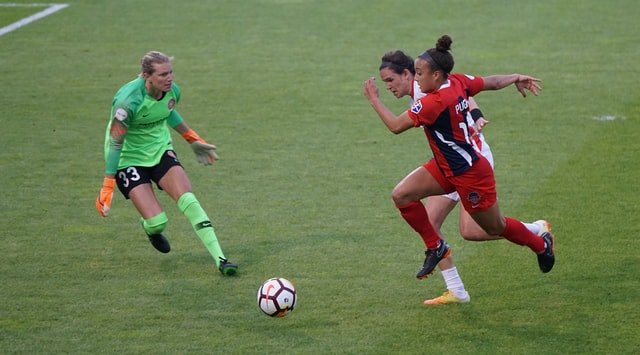Transfers in soccer are an essential part of most of the soccer leagues around the world. Usually, there are only a few soccer players that play for only one soccer team throughout their whole professional career.
In other words, soccer players move between soccer clubs all the time. These moves are either permanent using a transfer contract, or are temporarily using a loan contract. This article will explain what soccer loans are and how they work.
Loans in soccer are contracts between soccer clubs that allow one club to lend a soccer player to another club for a certain period of time. Soccer players on loan play for their new team until their loan contract ends, and then they rejoin their parent team or extend the loan contract duration if both clubs agree to do so.
So in other words, a loan is simply when a soccer club borrows a player from another club for a few seasons and then gives them back.
But if permanent transfers exist in soccer, why would soccer clubs go for loans instead?
Why do soccer clubs loan their players?
Loaning a soccer player instead of selling them permanently has some benefits for both of the teams involved in the loan. It also has some benefits for the loaned players themselves.
The benefits of loans in soccer for the loaner.
1- Develop the experience of young soccer players
It’s true that young soccer players already have what it takes to perform well in a big league since they have been already training their whole life for these matches.
However, it might take these young players some time to fully adapt to playing with a professional soccer team in stadiums that hold tens of thousands of soccer fans.

For this reason, many big soccer clubs send some of their young soccer players to different clubs on a loan so that these players gain first-team experience and come back to their parent team fully ready to compete in big soccer leagues.
But you may ask. Why doesn’t the parent team give the needed experience to their young players by themselves?
The answer to this question is quite simple. Using young and new soccer players during a match is risky.
Most of the top soccer clubs around the world do not risk using the young players with no experience at all during their matches because the club’s reputation and money is at stake during every one of these matches.
In other words, big soccer clubs can’t afford the mistakes that the young and inexperienced soccer players might make in their first few games with the team. For this reason, loaning some of these young players to smaller clubs so that they gain the needed experience is one of the best options for these big clubs.
2- Keep the currently unneeded players active.
Soccer players should remain active all the time. They should run during most of the week days and they should keep playing matches every now and then to keep their fitness level high.
However, some players might not be needed for a while by their team. This happens especially in big teams where the team has more than enough good players for the exact same position on the field.

If the team’s coach prefers one of the players over the others, then they might decide to not give the other players a lot of chances to play, and these players will have to sit and watch the game from outside the soccer field even if they were excellent players.
In these situations, the club might decide to send the inactive players on loan just to make sure that they do not lose their momentum and that they maintain their fitness level so that when they come back they remain as ready as they were in case the coach changes their mind about them or in case a new coach joins the team.
But you may ask here. If the players aren’t needed at the moment, then why not permanently selling them instead of loaning them to other teams?
The answer is that these players will most probably be needed later in the future. For example, let’s say that players A and B are competing for the striker spot at a soccer team. Player A is better than player B but he/she is 33 years old while player B is only 24 years old.
In other words, even if player A is currently better, they might not perform player B after 2 ~ 3 years due to their age. This means that if player B goes on a loan for 2 years, they might have a better chance for claiming their place as the team’s main striker when they come back since player A won’t be as good.
You can learn more about what a striker is in soccer in this detailed article.
One thing to note here is that soccer clubs might loan a player even if they are not planning to put them back on the team later on in the future.
This happens when the club wants to sell the player as a permanent transfer to another club but no other club is showing any interest in getting the player permanently at the moment, so the club may decide to send the player as a loan to another club just to give them a chance to keep playing somewhere else instead of having to sit on the bench for the rest of their career.
3- Handle the players who aren’t happy with the club.
Players are humans after all, and they might sometimes not be satisfied with the way their club is operating or they might not have good chemistry with their current teammates on the field.
For this reason, the soccer club that owns these players might decide to send them to another club as a loan while hoping that they perform better when they come back.
While the player is on loan, their parent team might undergo some changes that might help the player resolve their issues with the club and/or establish chemistry with their teammates.
4- Reduce some of the club’s expenses
If a soccer club has a lot of players that aren’t really used much during the club’s matches but are definitely on the payroll of the club, then this club might decide to send some of their players on loans just to reduce the costs of running the club.
After all, soccer clubs are businesses that need to be careful about where they spend their money in order to survive. If these clubs find value in the players who currently do not fit with the team, then sending them on a loan can sometimes reduce the costs of the club depending on how the contract was set.
So, these are generally the main benefits for the loaners. But what about the borrowers?
The borrowing soccer club gains a great player on their team.
The teams who borrow players from other teams using loans are usually small clubs. Sometimes, big soccer clubs borrow players from other big clubs, but this doesn’t happen as much as having a big soccer club loan a player to a smaller club.
With that in mind, when big clubs give a young and a promising soccer player as a loan to smaller clubs, the smaller clubs will get the chance to have a great soccer player on their team without having to pay the 10s of millions of dollars to get them to join the team.

Also, the small club may not even have to pay all of the wage of this young player (more on this later in this article). In other words, loans in soccer give small soccer clubs a chance to have a young and a promising soccer player on their side for a number of seasons without having to go bankrupt just to pay for their wages or pay their transfer fee.
Which team pays the wages of a loaned soccer player?
Which team pays the wages during a soccer loan is up to both clubs to decide. In other words, there are no rules that force which club should pay the wages of the player.
The 2 clubs will do some negotiations and decide who is going to pay for the player. Sometimes, both clubs pay for the player. The parent club pays a percentage of the loaned player’s wage and the other club pays the rest.
Other times, the parent club pays all of the player’s wage and asks the other club to make sure that the loaned player starts in a lot of matches on their team. The reason the parent club might do that is to make sure their player is truly gaining the needed experience.
So in other words, the parent company usually pays more if they want to have influence on what the loaned player will do at their new club. However, sometimes the team who borrows the player are the ones who pay the full wage of the player if they are the ones who are in need of the player.
So to sum this up, the 2 clubs involved in the loan decide among themselves how they are going to split the wage payment of the loaned player.
What are some of the loan rules in soccer?
Like everything in life, loans in soccer have their own set of rules that the soccer clubs should abide by. These rules are usually put in place so that none of the soccer clubs involved abuse the loaning system.
Before we dive into the rules, loans should be divided into 2 categories:
- Local loans
- International loans
Local loans are loans that take place between clubs that are from the same country. For example, loans between soccer clubs that compete in La Liga are considered local loans. While loans that take place between soccer clubs that compete in different countries are considered international loans.
While FIFA is the organization that sets the loans rules for most of the international club competitions (eg: Champions league, Europa League), the local loan rules inside a country’s local leagues can be decided by the country’s domestic soccer association.
For example, in the United Kingdom, the number of loans that each club can do during a soccer season is limited.
Another example is the MLS’s age limit when it comes to local loans. The United State’s MLS requires that loaned players be 24 years old or less at the time of the loan if the loan is occurring between 2 MLS clubs.
The rules of the players loaning system in soccer can also differ inside soccer competitions that are held inside the exact same country.
For example, in the United kingdom’s Premier League, if one of the Premier League soccer clubs loans a player to another Premier League club, then this player is not allowed to compete against their parent club inside the Premier League. However, they are allowed to play against their parent club in other local English competitions.
As a side note La Liga, which is Spain’s main league competition, allows the loaned players to play against their parent team. However, keep in mind that the parent team can include in the loan contract that they do not want their players to play against them.
In other words, Spain leaves it up to the teams involved in the loan whether they want to let the loaned player play against their parent club or not in La Liga.
To sum up this section, the loans rules vary depending on the soccer leagues that the clubs involved competes at. However the most common rules are that the players are not allowed to play against their parent team, and that there are limits to how many loans a soccer team can be involved in during a single season.
With that said, I will end my article here. Here’s a quick summary of what you have just read.
SUMMARY
A loan in soccer is when a soccer club gives one of their players to another club for a certain period of time. The main reason behind soccer loans is to develop young players and give them real experience before they start playing with their parent team.
The rules behind soccer loans differ from one soccer competition to another, but there are some rules that are common among most of the biggest soccer leagues around the world.

